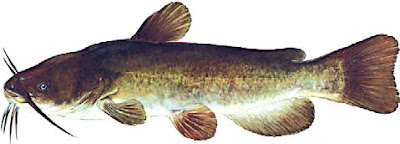Black Crappie
Grows 8-12 inches long; occasionally larger. With exception of the Adirondacks, common in waters across the state. Prefer clear, quiet areas of lakes, ponds and larger rivers with abundant vegetation. Eat small fish and insects.
Brown Bullhead
Averages 8-14 inches long. Easily recognizable by its broad, flat head and dark barbels (whiskers) around face. Has sharp spines on dorsal and pectoral fins. Very adaptable, it is the most common catfish in New York, found in cool Adirondack lakes, but most abundant in warm water ponds, lakes and larger, slow moving streams. Night time bottom feeder, uses barbels to locate food, including insects, snails, worms and small fish.
Common Carp
Large fish, carp average 15-20 inches long, but can grow to over 40 pounds in weight. Have large, heavy scales and two short barbels (whiskers). Found across the state except in cold trout streams and lakes. Prefers slow moving water with a soft bottom. Adults eat a variety of plant and animal material, often stirring up a cloud of mud as they feed.






